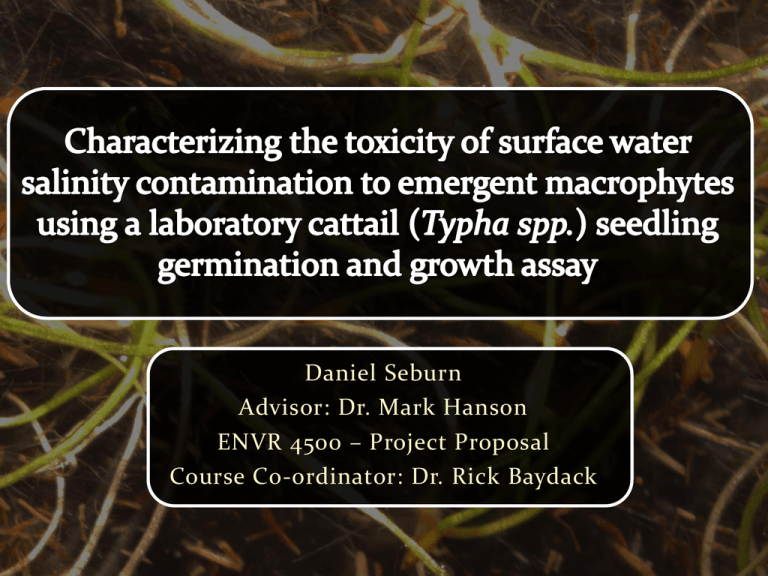File
advertisement

Daniel Seburn Advisor: Dr. Mark Hanson ENVR 4500 – Project Proposal Course Co-ordinator: Dr. Rick Baydack 2 1) Develop laboratory Typha spp. germination and root/shoot elongation assay to generate useful experimental data regarding salinity impairment of ecologically important emergent macrophytes 2) Perform experimental outdoor in-situ mesocosm assays as a supplement to laboratory data 3) Review local environmental monitoring data to make recommendations for further investigations Typha spp. (cattail) Characterize salinity toxicity 3 • Aquatic Macrophytes important for: • Nutrient removal (cleaning up Lake Winnipeg algae bowl) • Provide food/habitat for variety of fauna • Used for phytoremediation of organic and inorganic pollutants in treated wetlands • SETAC Global Plants Advisory Group recently identified the need to develop standardized methods for aquatic macrophyte assays, other than Lemna spp. assays (Arts et al., 2010) • Use Typha seedling bioassays to characterize salinity impairment to rooted, emergent macrophytes 4 • Excess salinization to wetlands typically occurs as a result of: • Saline sewage effluents • Road salt de-icing compounds in runoff water • Poor hydraulic engineering in coastal lagoon areas • Raney and Eimers (2014) recently analyzed trends in water quality data in southern Ontario over the past 30+ years • They found that 58 of the 64 sites had significantly increasing chloride concentrations, with the highest concentrations always occurring during spring melt near urban centers (coinciding with road salt applications) • Similar trends found in surface waters in northeast USA (Kaushal et al. 2005) • In response to the environmental hazards posed by road salts, a code of practice for the proper management of road salts was developed under CEPA in April 2004 • Goal to improve the reporting and management of road salt usage among municipalities, provincial governments, and other frequent applicators (Environment Canada, 2012) 5 • Typha assay – Seed Preparation Method • Based on methods from McNaughton (1968) and recent studies • Female flowering spikes collected from Oak Hammock Marsh, Manitoba in Fall 2013 • 1 litre Technicon Commercial Blender • 700ml RO water • 40g Fisher Brand Sparkleen powder soap • 5 ml Sodium Hypochlorite (bleach) • Added in order to separate seeds from debris and remove any residual chemicals left on seeds • Blended for 30 seconds, then mixture added to dilution vessel 6 7 • 15 individual seeds added to split petri dishes, 4 reps/treatment • Used seeds from Oak Hammock Marsh as well as imported seeds from plant-world-seeds.com (UK) • Seeds left in Conviron growth chamber for seven or fourteen days under varying temperatures and photoperiods • Germination success counted and root/shoot growth measured with Infinity1 microscope and image analysis software 8 • Infinity Analyze Software – Calibration and Measuring 9 • Similar germination success between seeds we collected (MB) and ordered seeds (UK) 100 MB Sourced Seeds UK Sourced Seeds Germination Success (%) 80 • Significantly less germination success without light, lower temp 60 • Germination success (52 to 71%) comparable to other studies assessing Typha germination: 40 20 0 A B C D E • 60 to 90% (Burgeois et al., 2012) • 80 to 90% (Moore and Lock, 2012) • 79 to 93% (Muller et al., 2000) Exposure Condition * A = No light exposure @ 25°C for 7 days B = 12 hours light/day @ 20°C for 7 days C = 12 hours light/day @ 25°C for 7 days D = 18 hours light/day at 25°C for 7 days E = 18 hours light/day at 25°C for 14 days 10 • UK sourced Typha latifolia seeds exposed to: • Three different laboratory grade salts • NaCl, CaCl2 * 2H2O, and KCl • Three different commonly used road salt compounds • No Name Road Salt (RS#1), Sifto Safe Step (RS#2), and Meltz All (RS#3) • Greatest concentration 32g/L, subsequent solutions prepared by serial dilution 11 Table 1: Measured conductivity (mS/cm) of each stock solution used in experiment. Control stock solution had a measured conductivity value of 0.014 mS/cm. Target Concentration NaCl CaCl2 KCl RS#1 RS#2 RS#3 1 g/L 1.105 1.145 1.134 1.145 0.584 1.653 2 g/L 2.085 2.205 2.101 2.012 1.304 2.831 4 g/L 3.985 4.036 3.996 3.781 2.174 4.753 8 g/L 7.925 7.545 7.689 7.154 4.002 8.801 16 g/L 15.834 13.641 14.609 13.084 7.685 15.371 32 g/L 26.625 25.134 26.013 25.863 14.865 24.194 12 • Seeds left in Conviron growth chamber for seven days at 25°C and 18 hour light to six hour dark photoperiod • Photosynthetically active radiation (PAR) levels were measured at five random locations in the growth chamber with an Apogee Quantum Flux Photometer (Model MQ-200) • 243 to 285 µmol m-2 s-1 • Study Design: • Six different compounds • Six concentrations of each compound (plus controls) • Five repetitions per concentration • Twenty seeds per repetition 13 Germination Success (%) 80 NaCl CaCl KCl Road Salt #1 Road Salt #2 Road Salt #3 60 40 20 0 Control 1 g/L 2 g/L 4 g/L 8 g/L 16 g/L 32 g/L Treatment Figure 2: Average germination success for Typha seeds exposed to increasing concentrations of laboratory grade salts and common road salt compounds. 14 Average Shoot Length (mm) 25 NaCl CaCl KCl Road Salt #1 Road Salt #2 Road Salt #3 20 15 10 5 0 Control 1 g/L 2 g/L 4 g/L 8 g/L 16 g/L 32 g/L Treatment Figure 3: Average shoot length for Typha seeds exposed to increasing concentrations of laboratory grade salts and common road salt compounds. 15 18 NaCl CaCl KCl Road Salt #1 Road Salt #2 Road Salt #3 Average Root Length (mm) 16 14 12 10 8 6 4 2 0 Control 1 g/L 2 g/L 4 g/L 8 g/L 16 g/L 32 g/L Treatment Figure 4: Average root length for Typha seeds exposed to increasing concentrations of laboratory grade salts and common road salt compounds. 16 Control CaCl – 1 g/L NaCl – 4 g/L RS#1 – 8 g/L RS#2 – 8 g/L RS#3 – 1 g/L 17 • Four parameter log-logistic concentration-response curves were generated for each compound and each endpoint using the Rstudio statistical software program (R Core Team, 2011) and our experimental data • Ten and fifty percent inhibition concentrations (EC10 and EC50, respectively) with standard error and 95% confidence intervals were subsequently calculated from the concentration-response curves Dose-Response Curve generated for RS#2 Shoot Length Inhibition Number of Emergent Typha Plants 18 Control 25 g/L 50 g/L 100 g/L 250 g/L 500 g/L 10 8 6 4 2 0 0 10 20 30 40 Days After Treatment 50 60 Figure 5: Typha emergence rates for in-situ mesocosm assays performed with 18 identical simulated wetland systems. 19 • Many herbicides and other potentially phytotoxic compounds are frequently applied/released and detected in local surface waters • Due to widespread eutrophication issues, characterizing phytotoxicity and changes to nutrient uptake dynamics are very important • Much work remains to be done Figure 2: Calculated hazard quotients for pesticides detected in Lake Winnipeg between the years of 1999 to 2012. Numbers indicate total number of detections and dashed line indicates HQ > 1. (Manitoba Conservation, unpublished data) 20 • Comparison of our compounds and endpoints (with calculated EC50’s) • Comparing our results to other experiments • Studies assessing salinity impairment in other macrophytes • Compare to the Scientific Criteria Document for the Development of the Canadian Water Quality Guidelines for the Protection of Aquatic Life – Chloride Ion (CCME, 2011) • Guideline currently recommended for short term exposures at 640 mg Cl- * L-1 and long term exposures at 120 mg Cl- * L-1 • Recommendations for further investigations of emergent macrophyte toxicity based on monitoring data and governmental reports • Widely used herbicides in Manitoba include 2-4D, atrazine, bromacil, dicamba, and glyphosate (Currie and Williamson, 1995) 21 Arts G, Davies J, et al. 2010. AMEG: the new SETAC advisory group on aquatic macrophyte ecotoxicology. Environ Sci Pollut Res 17:820–823. Bourgeois, B. r., S. Hugron, et al. 2012. Establishing a moss cover inhibits the germination of Typha latifolia, an invasive species, in restored peatlands. Aquatic Botany 100(0): 76-79. Carlson JC. Anderson JC, et al. 2013. Presence and hazards of nutrients and emerging organic micropollutants from sewage lagoon discharges into Dead Horse Creek, Manitoba, Canada. Science of the Total Environment 445-446: 64-78. CCME. 2011. Canadian water quality guideline for chloride: Scientific criteria document (draft). Canadian Council of Ministers of the Environment, Winnipeg, MB, Canada. Currie RS, Williamson DA. 1995. An assessment of pesticide residues in surface waters of Manitoba, Canada. Manitoba Environment, Water Quality Management Section, Winnipeg, MB, Canada. Environment Canada. 2012. Five-year Review of Progress: Code of Practice for the Environmental Management of Road Salts. Environment Canada, Ottawa, ON, Canada. Kaushal S, Groffman P, et al. 2005. Increased salinization of fresh water in the northeastern United States. PNAS 102(38): 13517-13520. Manitoba Conservation. Unpublished Data. Water Quality Management Section. Manitoba Conservation and Water Stewardship 123 Main Street, Suite 160 Winnipeg MB R3C 1A5. McNaughton SJ. 1968. Autotoxic Feedback in Relatin to Germination and Seedling Growth in Typha Latifolia. Ecology 49(2): 367-369. Moore, M. T. and M. A. Locke . 2012. Phytotoxicity of Atrazine, S-Metolachlor, and Permethrin to Typha latifolia (Linneaus) Germination and Seedling Growth. Bulletin of Environmental Contamination and Toxicology 89(2): 292-295. Muller SL, Huggett DB, et al. 2001. Effects of Copper Sulfate on Typha latifolia Seed Germination and Early Seedling Growth in Aqueous and Sediment Exposures. Archives of Environmental Contamination and Toxicology 40(2): 192-197. Raney S, Eimers C. 2014. Unexpected declines in stream phosphorus concentrations across southern Ontario. Rapid Communication 71: 337–342.





